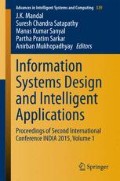Abstract
Recycling is the necessary concept for survival of the today’s global environment. To encourage this concept, in present article we have developed a reverse logistics model for deteriorating items. The deterioration is treated as non-instantaneous rate with time dependent demand rate. The production rate is directly related with demand rate under the effect of learning. The whole study is done in an inflationary environment. The goal of this study is to find optimum value of total cost function. At the end this article model is numerically illustrated and a sensitivity analysis is performed.
Access this chapter
Tax calculation will be finalised at checkout
Purchases are for personal use only
References
Schrady, D.A.: A deterministic inventory model for repairable items. Naval Res. Logistics Q. 14, 391–398 (1967)
El Saadany, A.M.A., Jaber, M.Y.: A production/remanufacturing inventory model with price and quality dependant return rate. Comput. Ind. Eng. 58(3), 352–362 (2010)
Alamri, A.A.: Theory and methodology on the global optimal solution to a general reverse logistics inventory model for deteriorating items and time-varying rates. Comput. Ind. Eng. 60, 236–247 (2010)
Singh, SR., Saxena, N.: An optimal returned policy for a reverse logistics inventory model with backorders. Adv. Decis. Sci. 21 (Article ID 386598) (2012)
Singh, S.R., Prasher, L., Saxena, N.: A centralized reverse channel structure with flexible manufacturing under the stock out situation. Int. J. Ind. Eng. Comput. 4, 559–570 (2013)
Yang, P.C., Chung, S.L., Wee, H.M., Zahara, E., Peng, C.Y.: Collaboration for a closed-loop deteriorating inventory supply chain with multi-retailer and price-sensitive demand. Int. J. Prod. Econ. 143, 557–566 (2013)
Jaber, M.Y., El Saadany, A.M.A.: The production, remanufacture and waste disposal model with lost sales. Int. J. Prod. Econ. 120(1), 115–124 (2009)
Konstantaras, I., Skouri, K.: Lot sizing for a single product recovery system with variable setup numbers. Eur. J. Oper. Res. 203(2), 326–335 (2010)
Hasanov, P., Jaber, M.Y., Zolfaghari, S.: Production, remanufacturing and waste disposal models for the cases of pure and partial backordering. Appl. Math. Model. 36, 5249–5261 (2012)
Singh, S.R., Saxena, N.: A closed loop supply chain system with flexible manufacturing and reverse logistics operation under shortages for deteriorating items. Procedia Technol. 10, 330–339 (2013)
Singh, SR., Saxena, N.: An integrated inventory model with remanufacturing of secondary material under shortages. In: Proceedings of 3rd International Conference on Recent Trends in Engineering and Technology, Elsevier. Nasik, India pp. 354–359 (2014)
Maity, A.K., Maity, K., Mondal, S.K., Maiti, M.: A production-recycling-inventory model with learning effect. Optim. Eng. 10, 427–438 (2009)
Singh, S.R., Jain, S., Pareek, S.: An imperfect quality items with learning and inflation under two limited storage capacity. Int. J. Ind. Eng. Comput. 4, 1–12 (2013)
Singh, S.R., Rathore, H., Saxena, N.: A two warehouse inventory model for deteriorating items with shortages under inflationary environment. In: Proceedings of 3rd International Conference on Recent Trends in Engineering and Technology. Elsevier, India pp. 385–391 (2014)
Author information
Authors and Affiliations
Corresponding author
Editor information
Editors and Affiliations
Rights and permissions
Copyright information
© 2015 Springer India
About this paper
Cite this paper
Singh, S.R., Rathore, H. (2015). Reverse Logistic Model for Deteriorating Items with Non-instantaneous Deterioration and Learning Effect. In: Mandal, J., Satapathy, S., Kumar Sanyal, M., Sarkar, P., Mukhopadhyay, A. (eds) Information Systems Design and Intelligent Applications. Advances in Intelligent Systems and Computing, vol 339. Springer, New Delhi. https://doi.org/10.1007/978-81-322-2250-7_43
Download citation
DOI: https://doi.org/10.1007/978-81-322-2250-7_43
Published:
Publisher Name: Springer, New Delhi
Print ISBN: 978-81-322-2249-1
Online ISBN: 978-81-322-2250-7
eBook Packages: EngineeringEngineering (R0)

